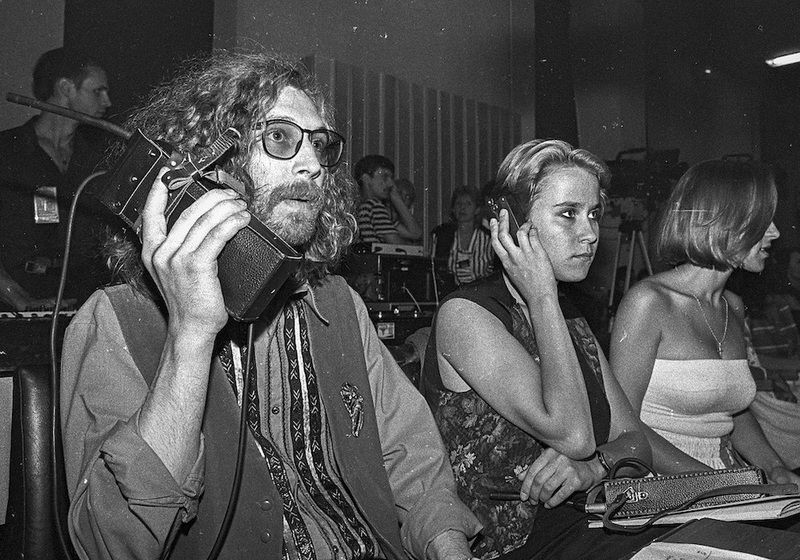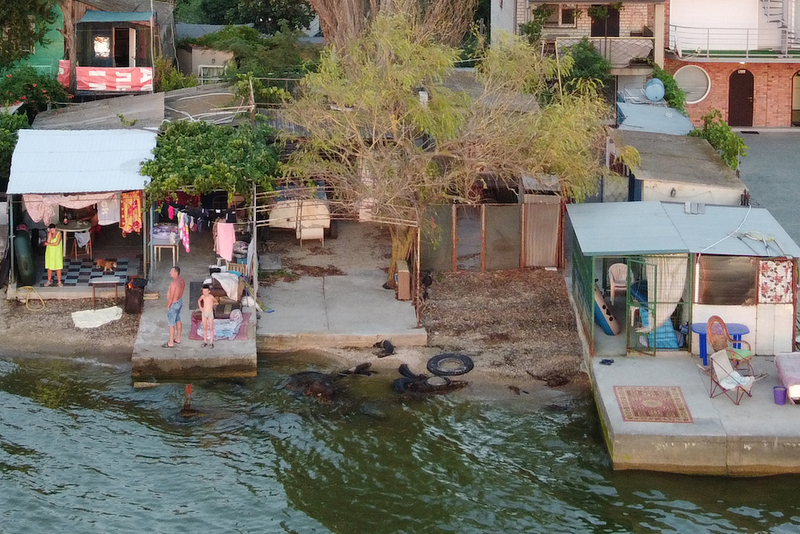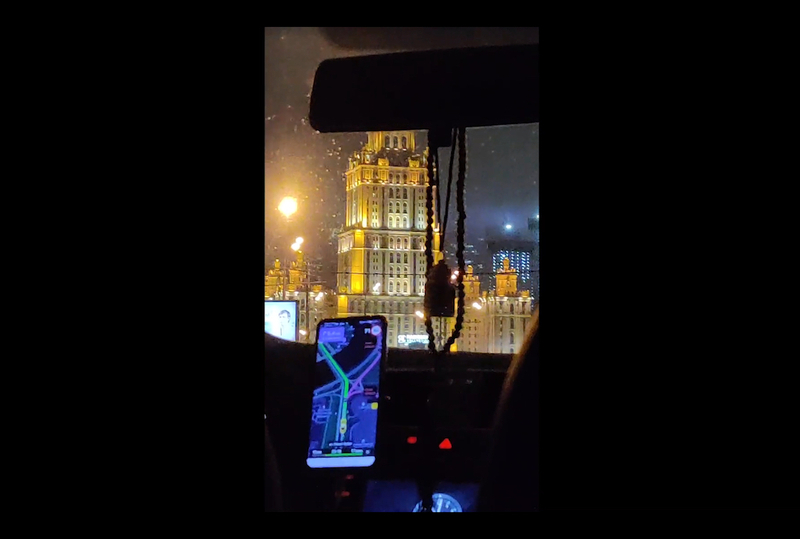For two weeks EastEast was showing Jonas Mekas’ famous diary film. One part of the footage for Reminiscences of a Journey to Lithuania was filmed by the legendary avant-garde artist in the 1950s in New York State, another part—in 1971, during a trip to the village of Semeniškiai, many years after he was forced to flee from his homeland as it was occupied by German troops. At our request, film researcher Maria Gribova reflects on this picture and a displaced person’s nostalgic odyssey into the irrevocable past.
“Lost paradise,” “abandoned home”—these are the figures that critical reflection uses to conceal, as if in a sarcophagus, the endless tangle of films made by Jonas Mekas. That same logic makes him an “exile” and “wanderer,” searching in vain for traces of an unattainable childhood.
In 1944, the Lithuanian Mekas—who at age twenty two decided to leave home, fearing the disclosure of his antifascist activities—was stopped on the way to Vienna and sent to the Elmshorn labor camp. He stayed there until World War II ended, and then on German territory for a few more years until he left through a UN program for war refugees to New York—forever. It seems that the chronicle of life’s “losses, losses, losseslosses, losses, lossesLost, Lost, Lost is a film edited by Jonas Mekas in 1976 from footage that he filmed over the previous 14 years, between 1949–1963.” suffered by the director—who himself preferred the modest title “filmerfilmerSee, for example: “A Conversation Between Jonas Mekas and Stan Brakhage.” Logos Journal (2/2: 2003); Mekas J. “Just Like a Shadow, Interview with Jérôme Sans.” Steidl Publishers, 2000.
”—encourages the description of his works in terms rife with tragedy. This is also prompted by the names that Mekas found for himself, his books, and his films: “Wilhelm Meister,” who wanders in search of “brief glimpses of beauty”; the guide through New York’s “WaldenWaldenWalden: Diaries, Notes, and Sketches was Mekas’s first full-length diary film, created in 1969 from material filmed over the four previous years.
,” whose literary “songs” and “symphonies” were dedicated to Petrarch. Amidst these representations, it becomes easy to poeticize a different, more measured definition of “filmer”: “a displaced person” gathering daily “reports,” “anecdotes,” and “letters.”
Taken together with the images from his video-diaries, full of lyrical spontaneity, the scale of the events Mekas experienced feeds the myth of the great American artist of Lithuanian descent. However, the myth is twice mistaken: first, when it erases Mekas’ subjectivity in the tireless manifestation of his authorship and second, when it deprives the manifestation of strength by repeating his personal story in the most commonplace epithets. Attempts to combine the personal and historical in such representations of Mekas risk an inadequate concreteness and lack of freedom. They emerge from following the filmer’s words and images at an insufficient distance and not understanding his expressions “obliquely” at the same time.
Mekas shot two thirds of the film Reminiscences of a Journey to Lithuania in 1971 during a short visit to his birthplace, the village of Semeniškiai. Within the deceptive myth of the great artist and his “lost paradise,” the film becomes a sorrowful odyssey into the irretrievable, yet still existing, past—blooming, hot, smelling of fresh milk. One can discern the beckoning calls of former friends, deceased loved ones, and lost time, but can also distinctly hear the living voice of the displaced person: “Yes, we are… we still are displaced persons. Even, even today. And the world is full of us, every continent is full of displaced persons. The minute we left, we started going home and we are still going home… I am still on my journey home.” The voice says: if the route of the Odyssey is marked, then it is the true Homeric course, the end of which hides in the shadow of the unimaginable distance. And so Odysseus will only be aided by one, who at the sight of an oar “shall say that thou hast a winnowing-fan on thy stout shouldershall say that thou hast a winnowing-fan on thy stout shoulderHomer, The Odyssey, translated by A.T. Murray (London: Harvard University Press, 1919). According to Tiresias’s prophecy, Odysseus may complete his journey and expiate his guilt before Poseidon only after reaching a land whose people have never seen the sea or ships. .” In reality, it is possible to return to Ithaca, but it is impossible to stay there; she cannot be forgotten nor can she be appropriated through memory.
“Displaced person” as a concept is political, if not bureaucratic. Quickly adopted after World War II, it served to designate people who were cast out or relocated by force until the Geneva Convention approved the status of refugee. This historical note would not matter if Reminiscences—released 20 years after the ratification of the convention that changed the international system of human rights—did not contradict the official definition so emphatically, repeating instead, like a mantra: “I am a displaced person on my way home, in search for my home.” And if Mekas, who not once called his own films “political,” had not expressed his doubt at the prospects of uniting cinema and politics so radically.
The displaced person’s home is still here, but it is impossible to enter: it is neither lost nor abandoned, but in another dimension of time
“Displaced person” is neither a normative term nor a metaphor; it is rather a metonymic image of the experience of discontinuity and incongruence. A displaced person is not a refugee: they do not abandon a place but are uprooted from it, setting off a series of changes and ruptures. Each new point on the map of life’s relocations may be recognizable and distinct from the next, yet none will become a space of permanence, no matter how long one remains there. The shots in Reminiscences capturing Mekas himself bear witness to what it feels like to move relentlessly and get stuck in a Kafkaesque chain of eternal points of temporary residence: he looks like the old immigrants from Stony BrookStony BrookStony Brook, Long Island is considered a suburb of New York City. In the 1950s, it was a gathering place for displaced persons from Lithuania who had arrived in the US. Footage that Mekas shot there was used in Reminiscences of a Journey to Lithuania and also in Lost, Lost, Lost. in that same film—awkwardly huddled together, lost, switching abruptly from laughter to deep reflection.
Even familiar sights do not relieve this confusion. “Our home, our house was still here and a cat meet us,” says the filmer, who arrived in Lithuania after a twenty seven year absence, but one hears neither joy nor nostalgic sadness in his voice. The displaced person’s home is still here, but it is impossible to enter: it is neither lost nor abandoned, but in another dimension of time, which falls away from the spatial location at the moment of violent tearing away. Although the house literally exists here and now, resembling its earlier self, it no longer coincides with the here and now of the one trying to enter it. A displaced person is not a nomad: he does not converge with the earth of his refuge, he does not feel it. He stands before a strange doubling of this place that can no longer be a living space, nor is it capable of entering the time of memory.
Reminiscences of a Journey to Lithuania uncovers the complexity of that experience in a way that is at once subtle and direct. In the film’s original title, Mekas—a man as faithful to writing and words as to filming and images—uses the notion of reminiscences. In light of his other works—Memories of Frankenstein, Autobiography of a Man Who Carried his Memory in his Eyes, Memories of Soho Quartet—the choice may seem arbitrary if it were not affirmed by repetition in the filmer’s poetic cycle “ReminiscencesReminiscencesSee Mekas J. There Is No Ithaca: Idylls of Semeniskiai & Reminiscences. Black Thistle Press, 1996.” about the years spent waiting in postwar Germany. That the dictionary makes synonyms of “memories” and “reminiscencesreminiscencesThe Russian cognate reministsentsii implies a sense of strangeness or derivative experience.
” masks the latter’s inherent haziness, which, though nourished by love, denies one the right to own the past. With reminiscences, all that remains is to try to catch them, to try to reconstitute them in narrative, otherwise they will slip away, attaching to something just as restless and fragile.
The fragility of recollection saturates the frames, while restlessness overtakes those watching them. The colorful, bucolic Reminiscences were made during the period when Mekas established himself by abandoning the tripod or filming at traditional speeds, although he had demonstrated those skills in earlier works like Empire (as cameraman), Award Presentation to Andy Warhol, or the footage for Williamsburg, Brooklyn. His shots of Lithuania resemble those of everyday life and the actions of FluxusFluxusFluxus is an international movement that united artists of various countries and continents aspiring to radically rethink avant-garde practices in the second half of the 20th century. Its name was invented by Lithuanian-born George Maciunas, who starred in Mekas’s film Zefiro Torna. Artists who participated in Fluxus include Joseph Beuys, Nam June Paik, Yoko Ono, Ben Vautier, and Wolf Vostell.; however the familiar mobility of the camera and quick editing elicit a strange sense of insecurity, which had not appeared as long as the lens of his BolexBolexThe Bolex is a 16mm portable movie camera. It was the first camera that Mekas obtained when he arrived in New York. Consequently, the filmer remained loyal to this choice and made the majority of his films with the camera.
was trained on city parks, New York pedestrians, or the habitués of avant-garde gatherings. This insecurity is a symptom of anxiety, and the latter results from the figures closest to Mekas appearing insistently in the frames. Through the filmer’s fixed attention, the faces of his mother, brothers, and friends—neither random nor famous, just overly intimate—are transformed into apparitions at the rate of the flowing reminiscences.
But he will say this outright only after forty years, in Out-takes from the Life of a Happy Man:
“Memories, they say my images are my memories. No no no! These are not memories: this is all real what you see—every image, every detail, everything is real, everything is real and it’s not a memory, it has nothing to do with my memories anymore. Memories are gone, but the images are here, and they are real!”
Translated from Russian by Larissa Babij





